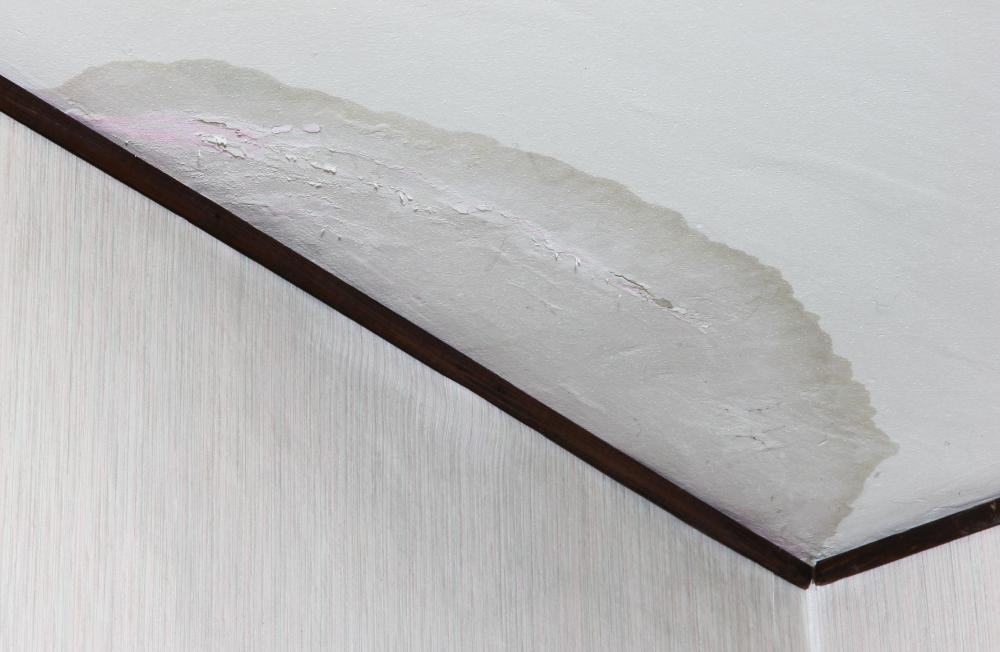At HomeQuestionsAnswered, we're committed to delivering accurate, trustworthy information. Our expert-authored content is rigorously fact-checked and sourced from credible authorities. Discover how we uphold the highest standards in providing you with reliable knowledge.
What can I do About Ceiling Water Damage?
As soon as you notice ceiling water damage, locate the source of the problem. You must fix the problem in order to repair the water damaged ceiling and prevent future damage. Once you fix the problem, you can clean up the mess. This might be as simple as drying the ceiling or as involved as removing ceiling mold. Next, you can focus on structural or cosmetic repairs to your damaged ceiling.
The first step in dealing with ceiling water damage is to locate the reason for the damage. The two most common causes for water damage on ceilings are a leaking roof and leaking or busted water pipes. Other common, and much more noticeable, causes include overflowing toilets, sinks or bathtubs that have been left unattended. Depending on how familiar you are with your home’s structure, you might be able to locate the cause of the water damaged ceiling yourself. If you’re not familiar, or you live in a rented home or apartment, consider contacting a professional, your landlord, or your building maintenance supervisor.

Once you know what’s causing the water damage, you can repair the problem. The time and cost it takes to repair the problem depends on the problem itself. For example, you might find that replacing a few leaking pipes is quicker and costs less than replacing the section of your roof that’s leaking. Unclogging an overflowing toilet is less expensive than replacing a damaged unit. Regardless of the cost, it’s important to properly repair the problem the first time so you can avoid ceiling water damage in the future.

After you fix the problem that caused your ceiling water damage, you can begin cleaning up the mess. The severity of the damage, as well as how long the problem existed before you realized it and repaired it, will determine the extent of the cleaning process. For example, if the damage isn’t severe and your water leak didn’t last long, you might only have to dry a water damaged ceiling. If the damage is severe, and the leak lasted for a long time, you might need to check for ceiling mold in addition to drying the ceiling. Mold is dangerous and can cause severe health problems, so unless you’re a mold specialist it’s always best to hire a professional for mold cleanup.

It’s best to wait until after you locate and repair the cause of the ceiling water damage before you begin fixing the structural and cosmetic damage. The steps you take to repair a water damaged ceiling will depend on the materials that make up your ceiling, the extent of the water damage, and your home repair abilities. You might be able to focus on light repairs and cosmetic work if the damage isn’t severe, but you might need to make replacements if it is severe. If you’re handy with home repairs, consider consulting a do-it-yourself home repair manual or website. Otherwise, it might be best to hire an expert.
AS FEATURED ON:
AS FEATURED ON:















Discussion Comments
Unless what’s broken can be easily fixed, I feel like it’s often better to hire a repairman. Not only are they trained to repair, but you could even learn some quick tips just from watching. They’ll also map out the problem and solution.
Sometimes, when things need to be fixed, we may try to find a solution on our own. However, this could only temporarily solve the problem. As a final piece of advice, learn from the experts.
Whether you’re dealing with a leaking roof, or even a broken garbage disposal, it’s important to take care of these problems right away. If you don’t, they’ll only get worse over time. Things don’t fix themselves, you know.
Post your comments